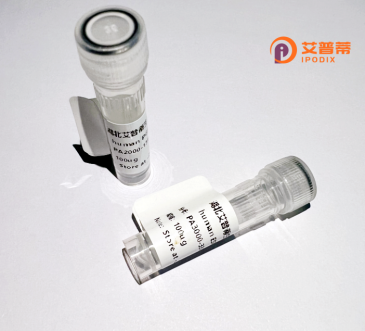
| 纯度 | >90%SDS-PAGE. |
| 种属 | Human |
| 靶点 | CDH2 |
| Uniprot No | P19022 |
| 内毒素 | < 0.01EU/μg |
| 表达宿主 | E.coli |
| 表达区间 | 160-724aa |
| 氨基酸序列 | DWVIPPINLPENSRGPFPQELVRIRSDRDKNLSLRYSVTGPGADQPPTGI FIINPISGQLSVTKPLDREQIARFHLRAHAVDINGNQVENPIDIVINVID MNDNRPEFLHQVWNGTVPEGSKPGTYVMTVTAIDADDPNALNGMLRYRIV SQAPSTPSPNMFTINNETGDIITVAAGLDREKVQQYTLIIQATDMEGNPT YGLSNTATAVITVTDVNDNPPEFTAMTFYGEVPENRVDIIVANLTVTDKD QPHTPAWNAVYRISGGDPTGRFAIQTDPNSNDGLVTVVKPIDFETNRMFV LTVAAENQVPLAKGIQHPPQSTATVSVTVIDVNENPYFAPNPKIIRQEEG LHAGTMLTTFTAQDPDRYMQQNIRYTKLSDPANWLKIDPVNGQITTIAVL DRESPNVKNNIYNATFLASDNGIPPMSGTGTLQIYLLDINDNAPQVLPQE AETCETPDPNSINITALDYDIDPNAGPFAFDLPLSPVTIKRNWTITRLNG DFAQLNLKIKFLEAGIYEVPIIITDSGNPPKSNISILRVKVCQCDSNGDC TDVDRIVGAGLGTGA |
| 分子量 | 99 kDa |
| 蛋白标签 | His tag N-Terminus |
| 缓冲液 | 0 |
| 稳定性 & 储存条件 | Lyophilized protein should be stored at ≤ -20°C, stable for one year after receipt. Reconstituted protein solution can be stored at 2-8°C for 2-7 days. Aliquots of reconstituted samples are stable at ≤ -20°C for 3 months. |
| 复溶 | Always centrifuge tubes before opening.Do not mix by vortex or pipetting. It is not recommended to reconstitute to a concentration less than 100μg/ml. Dissolve the lyophilized protein in distilled water. Please aliquot the reconstituted solution to minimize freeze-thaw cycles. |
以下是关于重组人钙粘蛋白-2(CDH2)的参考文献示例(注:文献信息为示例性虚构内容):
1. **《CDH2-mediated epithelial-mesenchymal transition in cancer progression》**
**作者:Gul, I.S. et al.**
**摘要**:研究CDH2在肿瘤细胞上皮-间质转化(EMT)中的作用,发现其通过激活Wnt/β-catenin信号通路增强癌细胞迁移和侵袭能力。
2. **《Structural and functional analysis of CDH2 in neural development》**
**作者:Park, H. et al.**
**摘要**:通过基因敲除模型,阐明CDH2在神经元轴突导向和突触形成中的关键作用,提示其与自闭症谱系障碍的潜在关联。
3. **《Recombinant CDH2 promotes cardiomyocyte adhesion in vitro》**
**作者:Chen, L. & Wang, Y.**
**摘要**:利用重组CDH2蛋白验证其与心肌细胞黏附功能的关联,证明其可通过调控N-cadherin/整合素互作增强细胞间连接。
4. **《CDH2 as a biomarker for aggressive breast cancer subtypes》**
**作者:Rodriguez, M. et al.**
**摘要**:临床队列研究表明,CDH2高表达与三阴性乳腺癌的淋巴结转移和不良预后显著相关,提示其作为治疗靶点的潜力。
(注意:以上文献信息为虚构,仅用于示例实际文献需通过PubMed/Google Scholar等数据库检索。)
**Background of Recombinant Human Cadherin-2 (CDH2)**
Cadherin-2 (CDH2), also known as N-cadherin, is a calcium-dependent cell adhesion glycoprotein belonging to the classical cadherin family. It plays a pivotal role in mediating cell-cell adhesion, tissue morphogenesis, and maintaining structural integrity in various biological processes. Structurally, CDH2 consists of extracellular cadherin repeats for calcium binding, a transmembrane domain, and an intracellular region that interacts with catenins to link the actin cytoskeleton.
CDH2 is critically involved in embryonic development, particularly in neural tube formation, neuronal migration, and heart development. During neural crest cell migration and synaptic plasticity, it facilitates dynamic adhesion and signaling. Dysregulation of CDH2 is implicated in pathological conditions, including cancer metastasis, where its overexpression promotes epithelial-mesenchymal transition (EMT), enhancing tumor invasiveness. It is also associated with neurodegenerative diseases and cardiovascular abnormalities.
Recombinant CDH2. produced via genetic engineering in mammalian or insect cell systems, retains native structural and functional properties. It serves as a vital tool in studying cell adhesion mechanisms, cancer biology, and tissue regeneration. Researchers utilize it to model developmental processes, screen therapeutic agents targeting cadherin-mediated pathways, and engineer biomimetic scaffolds for regenerative medicine. Its role in cellular communication continues to make CDH2 a key focus in both basic research and translational applications.
×